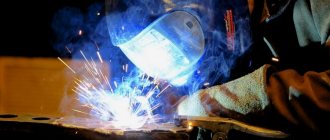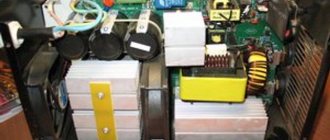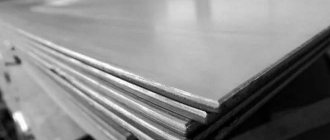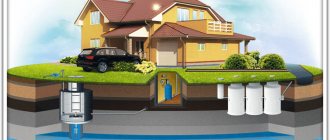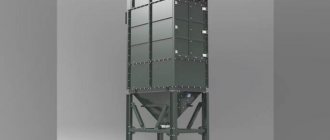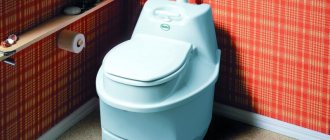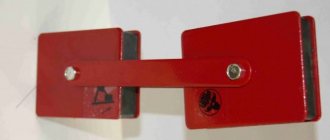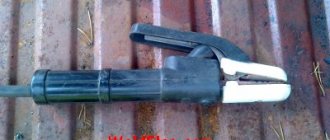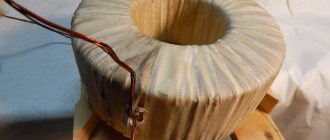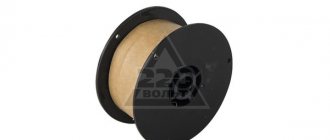Home / Accessories and parts
Back
Reading time: 2 min
0
1466
The mechanism of a welding machine includes various components and assemblies. The correct and complete functioning of the unit depends on correct assembly.
One of the key parts of the welding machine is the diode bridge. Working with other parts of the mechanism, it is responsible for converting constant energy into pulsating energy.
It is difficult to determine what diodes intended for welding equipment are. There are many interpretations of this term, which makes it difficult for beginners to understand the definition of diodes for welding.
Many welders have their own opinion on this matter, textbooks also give different information. You can understand this term yourself only if you understand electrical engineering.
Here we will briefly talk about the importance of welding diodes and diode bridges, the nuances of assembly and operation.
- general information
- Types of diodes for welding
- Structure of the diode bridge
- Conclusion
Energy conversion during welding machine operation
When connected to the network, the current first flows into a step-down transformer. An alternating electromagnetic field will excite a current in the secondary winding with the parameters required for the welding machine. It will have lower voltage and higher current.
It then passes through a rectifier unit, which will ensure that the current has the same polarity. In this case, significant pulsations will remain. To smooth them out, it will be passed through a capacitor unit. After it, the electricity used directly for arc welding will be largely stable in order to create a high-quality and reliable seam.
Scheme of operation of a diode bridge Source promkomrostov.ru
Structure of the diode bridge
The rectifier circuit uses from two to five diode elements. The standard scheme assumes the presence of four. The number of elements in a circuit is related to the amount of current required to do the work.
This is a direct connection - more diode elements, higher current. Here we will consider a circuit with four diodes.
To assemble a standard bridge, two elements are connected to each other in parallel. Their focus is different.
The second pair is connected in direction to each other. If the connection is correct, a rectifier is formed.
Various types of welding rectifiers
Depending on the model, various schemes may be used for this purpose. The following types of rectifiers are used:
- Operating on the basis of a transformer.
- Built on the use of transistors that provide rectification and smoothing of the current.
- Diode bridges.
- Using a choke, which is designed to contain sudden surges in current and voltage.
- Based on the use of thyristors.
- Inverter converters, which increase the frequency, bring the current and voltage to the parameters required for operation.
The use of a diode bridge is considered one of the most effective methods of obtaining current with the parameters required for operation.
The following video describes how to assemble a diode bridge:
Video description
How to assemble a diode bridge
There are also other ways to classify welding equipment. The one that is based on the use of various types of characteristics is often used:
- Rectifiers, which are characterized by steep characteristics, are usually used for manual arc welding. They are also used for working with non-consumable electrodes in a special gas environment. Such a device is capable of creating radio interference, which is suppressed by using appropriate filters.
- Devices with rigid characteristics are used to work with electrodes that melt in carbon dioxide.
- Universal devices can be used for all types of welding work.
These devices must be distinguished by the strength of the current used. Power diodes are designed to operate in cases where it is significant. Industrial level welding machines designed for a three-phase voltage of 380 V can operate with a current of up to 400 A. For single-phase it is 125-180 A.
Operating principle of a welding machine circuit Source ice-people.ru
Definition
In simple terms, a diode bridge is a standard rectifier. It consists of several powerful power diodes connected into a single circuit. On the right is a diagram of a diode bridge. This is his standard scheme, which with experience can be modified to suit your needs. The diodes are attached to the radiators using bolts and nuts. This entire structure is under constant voltage and is designed to perform a simple but important role - to convert alternating current into pulsating current. This process is called straightening, which is why welding bridges are called rectifiers.
By the way, one of the most effective rectifiers is VD 306. It is manufactured by many factories and even the welders themselves make it with their own hands from improvised materials. Factory-made copies allow you to smoothly regulate the current, but at the same time they consume quite a lot of electricity - about 12 kilowatts, and weigh 100 kg. Agree, this is not a very convenient device for amateur welding in the garage. Therefore, it is used in workshops and factories. And at home, they use homemade rectifiers made from diodes or more compact devices. The use of diodes allows you to solve several problems at once:
- The diode bridge stabilizes voltage drops and helps devices with weak technical characteristics start up.
- The quality of the weld becomes better.
- The arc heals easier and faster, even if the device produces a low voltage reading.
- A diode bridge on the welding machine improves arc characteristics. It burns more stable and longer.
Pros and cons of using a diode bridge
In some devices, instead of using a diode bridge for a welding machine, a transformer is included in the design. The latter method provides lower quality work. A circuit with a diode bridge allows you to take advantage of the following advantages:
- With its help, the electric arc becomes more stable.
- Current rectification contributes to more economical energy consumption during operation.
- Relatively high efficiency.
- The rectifier not only converts current, but also stabilizes voltage. It allows the welding machine to operate reliably even in cases where the power grid is unstable.
- The amount of spatter is reduced during welding.
- Compared to using a transformer when using a diode bridge, the device has less weight and more compact dimensions.
- Carrying out welding work ensures higher reliability of the connection.
Welding rectifier disassembled Source ice-people.ru
However, the use of diode bridges also has the following disadvantages:
- The parameters of energy coming from the electrical network play an important role. The use of diode bridges puts forward certain stability requirements.
- Higher quality of work is associated with a small loss of power.
- Higher risk of short circuit.
- The use of this method causes an increase in the cost of equipment.
The use of diode bridges for rectification ensures higher welding quality.
The master must constantly monitor the performance of the device Source radioelementy.ru
Welding Application
Any transformer DC welding machine or inverter contains power diodes. They are designed to rectify alternating current. To increase the efficiency, the diodes are connected in a bridge circuit, in which case both half-cycles fall on the load.
In a transformer welding machine, rectifier diodes are installed at the output of the secondary winding. Welding equipment has a step-down transformer; accordingly, the no-load voltage is significantly lower than the input voltage, so high-power and low-frequency devices are required here. B200 rectifier diodes (maximum current 200A) are suitable for this.
The welding inverter requires two rectifiers. One is located at the input of the power source. It converts alternating current 220 volts 50 Hz into direct current, which is further converted into alternating current of high frequency (40-80 kHz).
With a device power of 5 kW, the rectifier diodes should have a reverse voltage of 600-1000 V and an average forward current of 25-35 A at a frequency of 50 Hz.
The second rectifier is located after the high-frequency transformer. Here the requirements are different. The maximum forward current must be at least 200 A at a frequency of 80 kHz, and the reverse voltage must exceed the open circuit voltage (60-70 V).
In any case, diodes from the powerful category are used, with a platform for mounting a radiator, since without heat removal the device will quickly burn out.
How to get the current needed for work
The power supply for the welding machine must meet the requirements of the specific model. There are 2 options:
- Single-phase voltage 220 V. It is often used to operate household welding devices. It provides a less uniform current compared to three-phase.
- Three-phase voltage 380 V. This option is often used when carrying out industrial welding. It is available for domestic purposes, provided that the owner can provide this opportunity. Such devices operate more stably and efficiently.
The frequency in both cases is 50 Hz.
The current regulator for welding is described in the video below.
Video description
CURRENT regulator for welding machine.
A voltage is supplied from the network, which varies according to a sinusoid. It cyclically becomes positive and negative. Entering the primary shell of the transformer, constant changes in current create an alternating electromagnetic field, which excites periodic fluctuations in voltage and current in the secondary winding. The difference is that at the transformer output the power consumption is reduced.
Then the current passes through the diode bridge. Since the input voltage varies according to a sinusoid, positive and negative pulses are received at the input, which alternate with each other. After passing through the diode bridge in the welding machine, the former remain unchanged, and instead of the latter, positive ones pass through, having the same amplitude. Thus, a strongly pulsating voltage of the same sign appears at the output.
In order to smooth out the pulsation, a capacitor unit is used for further processing. Its output produces a constant voltage with a high level of stability.
Diagram and view of a diode bridge consisting of 4 diodes Source radioelementy.ru
Rectifier for welding machine
A rectifier for a welding machine can be created on the basis of powerful diodes of type B200 (maximum current 200A). Let us immediately note that due to the rather high price of power diodes, it is better to look for them at the radio or flea market.
Diode B200
Diode bridge
These diodes are of impressive size, and their housing is mounted on an aluminum radiator. Moreover, the diode body, and therefore the large radiator, is under voltage, so the diodes with their radiators must be attached so that they do not have contact with each other, without touching the conductive parts of the welding machine body.
Power diodes with radiators for a welding rectifier.
This inconvenience with fastening leads to the fact that the dimensions of the assembled welding diode bridge grow too much, increasing and complicating the design of the welding machine as a whole. Using the same diode, but with a different polarity (VL200), allows you to combine radiators into two pairs.
Diodes of different polarity with radiators, for a diode bridge of a welding machine.
For radiators, you may need to drill a hole and tap threads to attach the diodes.
There are already ready-made diode bridges on sale - integrated in one housing. The size of one such diode bridge is comparable to the size of a matchbox or one B200 diode without a radiator, with a maximum current of 30-50A, and the price is much lower.
50A diode bridge
If the integrated diode bridges are connected in parallel, then together they can withstand higher currents. However, the reliability of such a welding rectifier will be significantly less than a rectifier made from type B200 diodes.
Diagram of parallel connection of diode bridges for high currents of a welding machine.
Strictly speaking, the total permissible current of such a combined rectifier is not equal to the sum of the maximum currents of the diode bridges included in it; they cannot have exactly the same parameters, which means that each passes through slightly different currents. However, if you assemble this circuit with some power reserve, taking into account the short-circuit current, you can achieve more compact dimensions than in the case of the B200. The fact is that the housings of the diode bridges are not energized and they can all be mounted on one common radiator, and you can freely mount such a rectifier wherever it is convenient inside the housing, or outside, of the welding machine. For a rectifier, 3-5 integrated diode bridges can be used, always of the same brand. As practice shows, they do not get very hot and can withstand short-term overloads without problems, despite the fact that the welding machine generally operates in a short-term mode. For better heat transfer, heat-conducting paste is applied between the diode bridges and the radiator. The contacts must be connected by soldering, otherwise the contacts will become very hot.
An inevitable voltage drop occurs at the rectifier of the welding machine, so at the output of the rectifier the voltage will be somewhere 4-5V less than the open-circuit voltage of the transformer (without a capacitor). In this case, the output voltage will not be strictly constant - its shape will be pulsating.
The form of the voltage rectified by the diode bridge
If you take measurements in idle mode with a DC voltmeter, then its readings will correspond to something like the effective value of a constant ripple voltage (readings are about 1.4-1.5 times less than the peak-to-peak voltage). In principle, conventional voltmeters are not designed to accurately measure this kind of signal. The voltage waveform can be smoothed out by installing a capacitor with a capacity of 5000-10000 μF at the output. In this case, the voltmeter readings will increase by approximately 1.4 times, since the capacitor at idle will be charged to the maximum amplitude voltage level. It is recommended to install a capacitor especially if the power source has a low output voltage (less than 40V) and difficulties arise when igniting the welding arc. In this case, it is better to connect the capacitor through a resistance of about 0.5-1 Ohm.
Circuit diagram of a welding machine rectifier, with a capacitor.
The need for a resistor is due to the fact that at the moment the arc is ignited, the end of the electrode touches the metal of the product - that is, a short circuit. If there is no resistance in the capacitor circuit, then an instant discharge of a large capacitor occurs; a high current pulse is accompanied by a loud click, and often destruction of the tip of the electrode or its instant welding to the metal of the product. Working with such a source is very inconvenient; the crackling sounds of the discharges get on your nerves. An additional resistor limits the current, smoothes the discharge of the capacitor, making arc ignition easy and soft.
When using the content of this site, you need to put active links to this site, visible to users and search robots.
Literature
How to choose
The most popular type of factory-made diode bridge is VD306. It is convenient in that it is equipped with the ability to perform smooth adjustments. It should be taken into account that during operation it consumes 12 kW of electricity. The weight of this device reaches 100 kg. This device is most convenient to use for industrial welding.
You can make a diode bridge with your own hands. It is made from power diodes. There can be from two to five of them in the scheme. A self-made diode bridge will cost less, but to create it, a specialist must have a professional understanding of the equipment.
A welding machine designed for three-phase voltage 380 V has the best performance characteristics. However, there is not always an appropriate power supply network available at the place of work. For example, if you need to carry out welding on a summer cottage, it is unlikely that you will be able to provide it with energy.
Such devices are heavier than those that use a single-phase network. The weight of the latter is in the range of 30-80 kg.
For reliable operation of a diode bridge, it is necessary that the voltage and current values used for which it is designed exceed the actual ones by 1.5-2 times. The maximum reverse voltage of the diodes used should be twice as high as that provided by the transformer. Powerful diodes for a welding machine are necessary for trouble-free operation.
Description of the operation of the diode bridge Source radioelementy.ru
How to make a straightener with your own hands?
If the craftsman has the necessary components, it is quite possible to make a homemade welding rectifier. Provided that all recommendations of specialists are followed, it is guaranteed to provide the process of manual arc welding with direct current, but it will be necessary to use a coated electrode.
It is also permissible to use wire without coating, but only if you have extensive experience in welding matters. For an inexperienced welder, it will be almost impossible to cope with it.
Diode bridge for welding machine.
Coating when melting the electrode prevents the penetration of air components into the molten metal of the welded joint. Without it, contact of molten metal with nitrogen and oxygen will reduce the strength properties of the seam, making it brittle and porous.
First you will need to select or wind up a step-down transformer with your own hands with the required parameters. Assemble the transformer before connecting the diode bridge.
If you choose to manufacture the device yourself, it is important to correctly calculate its elements, including:
- magnetic circuit parameters;
- current number of turns;
- cross-sectional dimensions of busbars and wires.
On a note! Calculations for the manufacture of transformers are carried out using a unified methodology, so this task does not present any difficulties even for an inexperienced welder with school knowledge of electricity.
The work cannot be done without LEDs: they are needed as current conductors in one single direction. The simplest diode rectifier, created using a bridge circuit, is mounted on a radiator for the purpose of heat exchange and cooling.
Powerful diodes for a welding machine, like the VD-200, emit a fairly large amount of thermal energy during operation. To ensure a falling current characteristic, a choke will need to be connected in series to the circuit.
Active variable resistance in such a circuit will provide the welder with the ability to smoothly regulate the welding current. Next, one pole needs to be connected to the welded wire, and the second to the work object.
An electrolytic capacitor in the circuit is needed as a smoothing filter to reduce ripple.
It is not difficult to wind the rheostat on your own, but for such a task you will need a ceramic core and nickel or nichrome wire. The actual wire diameter will be determined by the amount of adjustable current in the welding operation.
The calculation of the rheostat resistance must be carried out taking into account the specific resistance of the electrode, its cross-section and total length.
Electrical circuit for welding with a diode bridge.
The current adjustment step for welding depends on the diameter of the turns. If you correctly assemble the listed parts into a single unit, the welding process will be accompanied by direct current. It would not be superfluous to install a resistor that prevents short circuits during operation.
It can occur when the wire touches metal without igniting the arc. If at this time there is no resistance on the capacitor, it will instantly discharge, a click will occur, the electrode will collapse or stick to the metal.
If you have a resistor, you can smooth out the discharges on the capacitor and make ignition of the electrode easier and softer. Making a device for rectifying weld current with your own hands will allow you to create the most accurate and durable welds. .
Safety instructions for use
Many types of welding diodes cannot work fully if there is excessive dust. Therefore, they need to be blown out before use. One of the most convenient means for this is using a household hair dryer. With its help, you can not only eliminate dust, but also remove moisture, which affects the electrical characteristics of the equipment. This purge must be carried out at least once a quarter.
Diode bridge for a welding machine Source prosvarku.info
If the welding machine has not been used for a year, it must be warmed up before use. To do this, the device is given the opportunity to work a little in all available modes. The time during which this preparation is carried out must be at least two hours.
During operation, the welding machine consumes a large amount of energy. It is important to ensure that it does not overheat. If its temperature exceeds the permissible level, you need to take a break from work.
It is necessary to check the presence of insulation on all conductive parts. If it is broken, it must be restored. The terminal connections must be secure. During operation, the welding machine must be grounded. If it overheats, one of the following may be the cause:
- There is a short circuit in the transformer winding.
- The cooling fan is not working at full speed.
- The core insulation is broken.
- Due to a malfunction in the secondary circuit of the transformer, the operating voltage is reduced.
If any malfunctions are found, they must be corrected before you start using the welding machine.
Repair of a welding rectifier Source kedrweld.ru
Types of welding diodes and their features
The key element of a welding diode bridge is the diodes themselves. Now the store offers many power diodes, with their own characteristics and features. Below you can see a table with the classification of diodes. Experienced welders manage to buy them at flea markets or radio markets, saving money. You can also try to look for the diodes you need at the nearest market, but keep in mind that dishonest sellers often sell broken or unsafe components. Buy them only if you understand electrical engineering.
Regardless of the type, diodes are also divided by current strength. They can be low power (with a rating of up to 3 * 102 milliamps), medium power (with a rating of 3 * 102 milliamps to 10 amperes) and high power (from 10 amperes or more). Powerful welding diodes are either spot or planar. Planar ones are used in rectifiers with low operating frequencies, and point ones are used in all other cases. One way or another, they are all used in the manufacture of a diode bridge for a welding machine. If diodes are used with a good welding machine, then better current conversion can be achieved.
